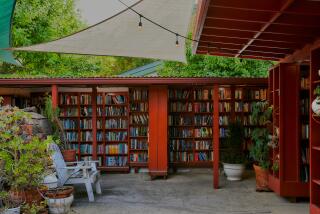STRUCTURES / OJAI INN AND COUNTRY CLUB : Hilltop Hacienda : The original nucleus of the pastoral property is intact and the new buildings are only flawed by comparison.
“When it comes to scenery, the Ojai Club is in a class by itself, and visitors will be well-repaid in the feast provided for the eye even if they do not hit one golf ball.”
So wrote noted golf course designer George C. Thomas Jr., quoted in the book “Arbolada” (published by Glastonbury Press in Ojai). The sentiment holds true today, almost seven decades later. This continuity is fairly remarkable, given the ferocious wheel of progress and development in Southern California.
Ironically, the only thing that threatens to trammel the scenery is the somewhat mundane architecture on the property.
This was the club that the late Pasadena-based architect Wallace Neff built in 1924. Neff, then a precocious 28-year-old, won an Honor Award from the Architectural Institute of America for his Ojai Club. He went on to enjoy a distinguished, eclectic career.
Many of his designs are in Ventura County, including the impressive Doheny Library at St. John’s Seminary in Camarillo.
But to get to Neff’s Ojai Country Club handiwork--the historical core of the property--you have to wend your way through the lobby and past other hotel buildings built in an extensive renovation and expansion project in 1988 to the tune of over $35 million.
Neff created a handsome, crouching hacienda structure situated on a hilltop. A horizontal style and site-friendliness were often qualities in Neff’s work, as they are here, where his relaxed Mission-style structure seems to hug the earth.
But even Neff’s structure has been amended and stripped of its pure form, though vestiges of the original remain and are worth seeking out. The inviting Neff Lounge, framed by two fireplaces and punctuated by large exposed beams, is intact.
Original herringbone pattern woodwork celebrates the dining room ceiling. A signature stairwell, outdoor and winding--which can be seen in the book “Wallace Neff, Architect of California’s Golden Age” (Capra Press; $50) has been preserved, although the original deep veranda has been closed off by a stylistically irrelevant entrance to the terrace.
Normally, one doesn’t think of golf courses, architectural heritage, and environmental preservation on the same mental bandwidth.
Golf, the stereotype goes, is an idle luxury, an elite pastime, and an extravagant use of precious acreage. And in Southern California, acreage is at a premium.
Of course, there wasn’t any such heightened real estate sensitivity in Southern Californians in the early ‘20s, when Edward Drummond Libbey rolled into town and began laying the groundwork for the Ojai we now know.
It was Libbey, the glass-manufacturing mogul, who essentially spearheaded the development of Ojai as it appears today. The post office and downtown commercial arcade--donated to the town by Libbey--give Ojai its cohesive ambience. He is also the Libbey of Libbey Park fame.
The history of Libbey’s country club property and its architecture has been one of change. Originally, a plan to create a larger, village-like complex atop the hill was proposed by George Washington Smith and his assistant Lutah Maria Riggs. The plan was rejected in favor of Neff’s more modestly scaled clubhouse.
By a twist of fate, the original, more-ambitious Smith plan may have resembled the present property, albeit with a different aesthetic agenda. Undertaken by the Los Angeles firm of Daniel, Mann, Johnson, and Mendenhall, the 1988 expansion involved increasing the 110 rooms to 218 and adding several new buildings to the 220-acre property.
There is nothing inherently wrong or offensive about the new buildings, encoded with all the familiar regional touches: red-tiled roofs, beige stucco walls and arch motifs throughout.
The original, inspired wave of Mediterranean architecture in this area from the 1920s, itself a conscious look backward, has given rise to a latter-day resurgence of Spanish-colonial style architecture in California. Much of it has been in a watered-down, Spanish-esque vernacular.
Functional, idiomatically correct, and ultimately generic, the newer structures on the property suffer mainly in contrast to the now-hidden nucleus of the Ojai property. Neff was a hard act to follow.
But still, there is the view--to die for. The Inn and County Club sits like a sprawling hilltop. The far side of the club, looking westward, looks out over a surprisingly tranquil valley view. The illusory paradisiacal ambience is broken only by the distant hum of traffic on California 33.
Visions of an unadulterated pre-industrial landscape are evoked by the rolling, rambling grassy hills--well, via the ersatz lawns of the golf course, but grass, nonetheless.
Still, you can order a “Pink Moment” burger at the restaurant and bask in the legendary Ojaian “pink moment” at dusk. It’s a fine vantage point from which to remind yourself that Ojai hasn’t been spoiled by success.
More to Read
Sign up for The Wild
We’ll help you find the best places to hike, bike and run, as well as the perfect silent spots for meditation and yoga.
You may occasionally receive promotional content from the Los Angeles Times.






